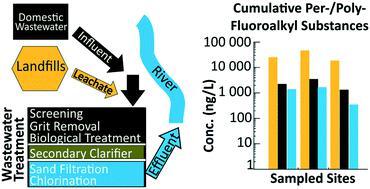当前位置:
X-MOL 学术
›
Environ. Sci.: Water Res. Technol.
›
论文详情
Our official English website, www.x-mol.net, welcomes your feedback! (Note: you will need to create a separate account there.)
Landfill leachate contributes per-/poly-fluoroalkyl substances (PFAS) and pharmaceuticals to municipal wastewater
Environmental Science: Water Research & Technology ( IF 5 ) Pub Date : 2020-03-13 , DOI: 10.1039/d0ew00045k Jason R. Masoner 1, 2, 3 , Dana W. Kolpin 1, 3, 4 , Isabelle M. Cozzarelli 1, 3, 5 , Kelly L. Smalling 1, 3, 6 , Stephanie C. Bolyard 3, 7, 8 , Jennifer A. Field 3, 9, 10 , Edward T. Furlong 1, 3, 11 , James L. Gray 1, 3, 11 , Duncan Lozinski 3, 12, 13 , Debra Reinhart 3, 14, 15 , Alix Rodowa 3, 9, 10 , Paul M. Bradley 1, 3, 16
Environmental Science: Water Research & Technology ( IF 5 ) Pub Date : 2020-03-13 , DOI: 10.1039/d0ew00045k Jason R. Masoner 1, 2, 3 , Dana W. Kolpin 1, 3, 4 , Isabelle M. Cozzarelli 1, 3, 5 , Kelly L. Smalling 1, 3, 6 , Stephanie C. Bolyard 3, 7, 8 , Jennifer A. Field 3, 9, 10 , Edward T. Furlong 1, 3, 11 , James L. Gray 1, 3, 11 , Duncan Lozinski 3, 12, 13 , Debra Reinhart 3, 14, 15 , Alix Rodowa 3, 9, 10 , Paul M. Bradley 1, 3, 16
Affiliation

|
Widespread disposal of landfill leachate to municipal sewer infrastructure in the United States calls for an improved understanding of the relative organic-chemical contributions to the wastewater treatment plant (WWTP) waste stream and associated surface-water discharge to receptors in the environment. Landfill leachate, WWTP influent, and WWTP effluent samples were collected from three landfill-WWTP systems and compared with analogous influent and effluent samples from two WWTPs that did not receive leachate. Samples were analyzed for 73 per-/poly-fluoroalkyl substances (PFAS), 109 pharmaceuticals, and 21 hormones and related compounds. PFAS were detected more frequently in leachate (92%) than in influent (55%). Total PFAS concentrations in leachate (93 100 ng L−1) were more than 10 times higher than in influent (6950 ng L−1) and effluent samples (3730 ng L−1). Concentrations of bisphenol A; the nonprescription pharmaceuticals cotinine, lidocaine, nicotine; and the prescription pharmaceuticals amphetamine, carisoprodol, pentoxifylline, and thiabendazole were an order of magnitude higher in landfill leachate than WWTP influent. Leachate load contributions for PFAS (0.78 to 31 g d−1), bisphenol A (0.97 to 8.3 g d−1), and nonprescription (2.0 to 3.1 g d−1) and prescription (0.48 to 2.5 g d−1) pharmaceuticals to WWTP influent were generally low (<10 g d−1) for most compounds resulting from high influent-to-leachate volumetric ratios (0.983). No clear differences in concentrations were apparent between effluents from WWTPs receiving landfill leachate and those that did not receive landfill leachate.
中文翻译:

垃圾填埋场渗滤液有助于全氟/多氟烷基物质(PFAS)和药品对城市废水的处理
在美国,将垃圾填埋场渗滤液广泛用于市政下水道基础设施,要求人们更好地理解有机化学对废水处理厂(WWTP)废物流的相关贡献以及相关的地表水向环境中受体的排放。从三个垃圾填埋场-污水处理厂系统中收集垃圾渗滤液,污水处理厂废水和污水处理厂废水样品,并与两个未接收渗滤液的污水处理厂的类似污水和污水厂样品进行比较。分析了样品中的73种全氟/多氟烷基物质(PFAS),109种药物以及21种激素和相关化合物。在渗滤液中检出PFAS的频率更高(92%),在进水中检出PFAS的频率更高(55%)。渗滤液中的PFAS总浓度(93100 ng L -1)比进水(6950 ng L -1)和污水样品(3730 ng L -1)高出十倍以上。双酚A的浓度;非处方药可替宁,利多卡因,尼古丁;垃圾渗滤液中的处方药苯丙胺,异丙苯吗啡,己酮可可碱和噻菌灵的进水量比污水处理厂进水量高一个数量级。污水处理厂进水的PFAS(0.78至31 gd -1),双酚A(0.97至8.3 gd -1),非处方药(2.0至3.1 gd -1)和处方药(0.48至2.5 gd -1)的渗滤液负荷贡献为一般较低(<10 gd -1)是由于进水与滤液的高体积比(0.983)而产生的大多数化合物。接受垃圾渗滤液的污水处理厂废水和没有垃圾渗滤液的污水厂废水之间的浓度没有明显差异。
更新日期:2020-03-13
中文翻译:

垃圾填埋场渗滤液有助于全氟/多氟烷基物质(PFAS)和药品对城市废水的处理
在美国,将垃圾填埋场渗滤液广泛用于市政下水道基础设施,要求人们更好地理解有机化学对废水处理厂(WWTP)废物流的相关贡献以及相关的地表水向环境中受体的排放。从三个垃圾填埋场-污水处理厂系统中收集垃圾渗滤液,污水处理厂废水和污水处理厂废水样品,并与两个未接收渗滤液的污水处理厂的类似污水和污水厂样品进行比较。分析了样品中的73种全氟/多氟烷基物质(PFAS),109种药物以及21种激素和相关化合物。在渗滤液中检出PFAS的频率更高(92%),在进水中检出PFAS的频率更高(55%)。渗滤液中的PFAS总浓度(93100 ng L -1)比进水(6950 ng L -1)和污水样品(3730 ng L -1)高出十倍以上。双酚A的浓度;非处方药可替宁,利多卡因,尼古丁;垃圾渗滤液中的处方药苯丙胺,异丙苯吗啡,己酮可可碱和噻菌灵的进水量比污水处理厂进水量高一个数量级。污水处理厂进水的PFAS(0.78至31 gd -1),双酚A(0.97至8.3 gd -1),非处方药(2.0至3.1 gd -1)和处方药(0.48至2.5 gd -1)的渗滤液负荷贡献为一般较低(<10 gd -1)是由于进水与滤液的高体积比(0.983)而产生的大多数化合物。接受垃圾渗滤液的污水处理厂废水和没有垃圾渗滤液的污水厂废水之间的浓度没有明显差异。



























 京公网安备 11010802027423号
京公网安备 11010802027423号